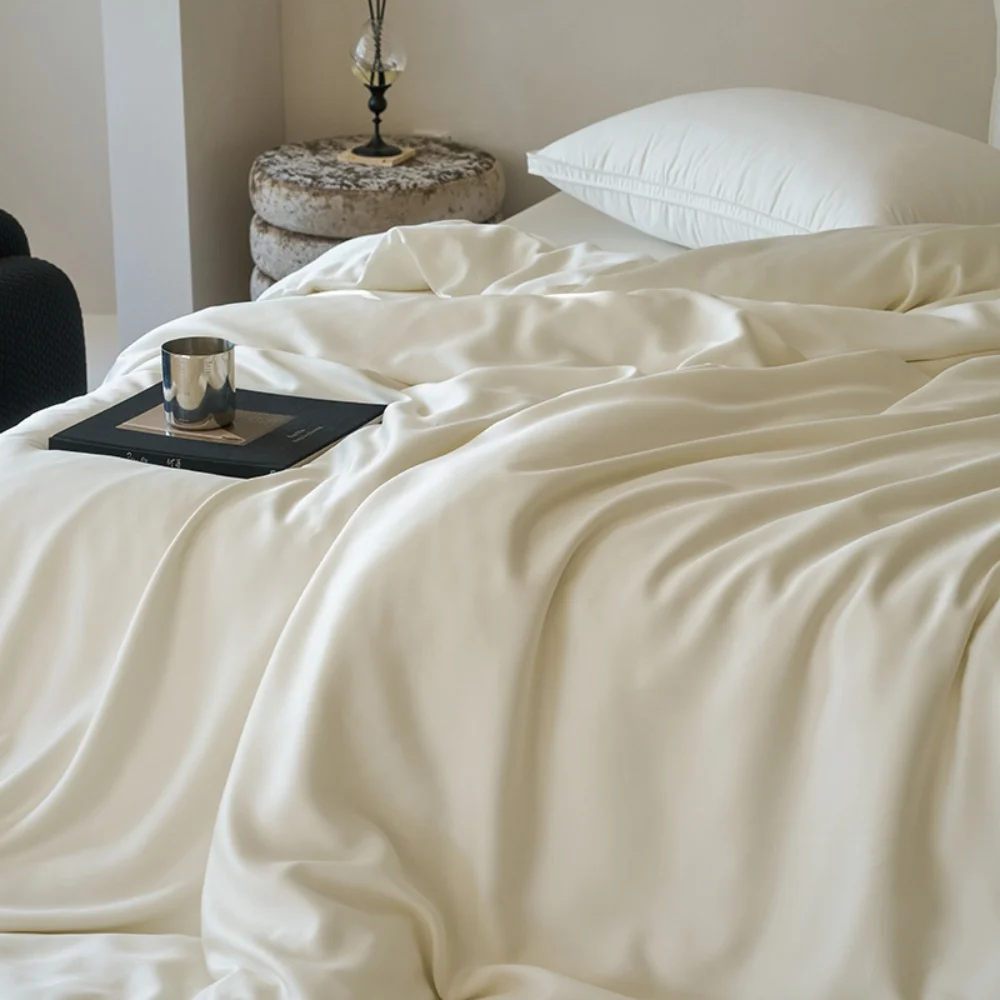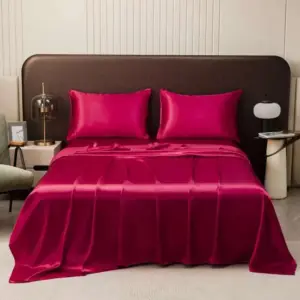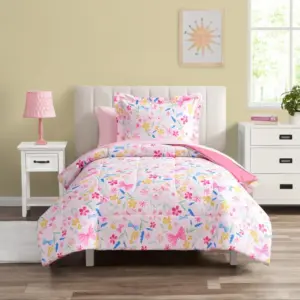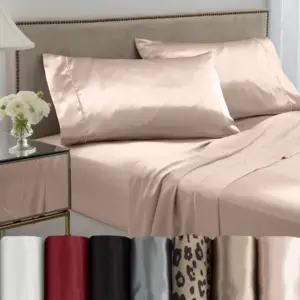Introduction: Understanding the Fabric Dilemma
When it comes to fabric choices for bedding, clothing, and everyday items, the question of “silk vs cotton: which is better?” often arises. This choice isn’t merely about preference—it can significantly impact your comfort, sleep quality, skin health, and even the longevity of your purchase.
Silk and cotton stand as two of the world’s most beloved natural fibers, each with distinct characteristics and benefits. While silk is renowned for its lustrous appearance and smooth texture, cotton has earned its reputation as the comfortable, breathable everyday fabric found in most homes worldwide.
The difference between these fabrics extends far beyond their feel. From their origins to their impact on your skin, hair, and sleep quality, each material offers unique advantages that might make it the perfect choice for your specific needs. According to industry statistics, while cotton remains the most widely used natural fiber globally, silk continues to hold its position as the premier luxury fabric choice.
At Sanctuary Soft, we specialize in premium silk bedding products, but we recognize that making an informed choice between these two exceptional materials requires understanding their fundamental differences. The “better” fabric ultimately depends on your specific requirements, preferences, and priorities—which is exactly what we’ll explore in this comprehensive comparison.
Understanding the amazing benefits of Mulberry silk sheets can transform your sleep experience, while the complete guide to Mulberry silk bed sheets provides deeper insights into what makes these luxury items so special. For those specifically comparing bedding options, our silk vs cotton bedding comparison offers detailed analysis to help you decide.
The Origins and Production: Silk vs Cotton Fundamentals
Silk’s Journey
Silk is a natural protein fiber produced by the silkworm, specifically the Bombyx mori moth caterpillar. The process begins when silkworms spin cocoons of raw silk threads. These cocoons are carefully harvested, and the long, continuous filaments are unwound to create silk thread. This delicate process requires precision to maintain the integrity of the fibers that can extend up to 1,000 meters in length from a single cocoon.
Mulberry silk, widely considered the premium variety, comes from silkworms fed exclusively on mulberry leaves. This specialized diet contributes to the creation of stronger, finer, and more uniform silk fibers. The quality of silk is measured in momme weight—with 19-25 momme representing the optimal balance between luxury and durability. Understanding what makes Mulberry silk special helps appreciate why it stands apart from other varieties.
Cotton’s Source
Cotton is a natural cellulose fiber that grows around the seeds of cotton plants. After harvesting, the cotton bolls undergo ginning to separate fibers from seeds, followed by cleaning, carding, and spinning to create cotton thread. The quality of cotton is typically measured by thread count—the number of threads woven into one square inch of fabric.
Various cotton types exist, including Egyptian cotton (known for its extra-long fibers), Pima cotton (prized for softness and luster), and Upland cotton (the most common variety). The differences between cotton quality measurements and silk’s momme weight are significant for buyers, as explored in our guide on thread count vs momme weight.
Environmental Considerations
Both fabrics have environmental footprints worth noting. Cotton cultivation traditionally requires significant water resources and pesticides, though organic options have reduced this impact. Silk production is generally less resource-intensive but raises ethical considerations regarding the silkworms used in the process.
Comprehensive Comparison: Silk vs Cotton Properties
To truly understand the differences between silk and cotton, let’s examine their key properties side-by-side:
| Property | Silk | Cotton |
|---|---|---|
| Texture & Feel | Smooth, lustrous with gentle drape | Soft but crisper, more textured |
| Breathability | Naturally breathable with excellent airflow | Highly breathable with good air circulation |
| Temperature Regulation | Adapts to body temperature; cool in summer, warm in winter | Good for heat dissipation but less effective at retaining warmth |
| Moisture Management | Wicks moisture away without absorption (absorbs up to 30% of its weight) | Highly absorbent (can hold up to 25x its weight in water) but retains moisture |
| Durability | Surprisingly strong when properly cared for; 19-25 momme provides optimal durability | Very durable, especially higher thread counts; withstands frequent washing |
| Hypoallergenic Properties | Naturally hypoallergenic; resistant to dust mites, mold, fungi | Not inherently hypoallergenic; can harbor allergens |
| Care Requirements | Gentle washing required; typically hand wash or delicate cycle | Machine washable; stands up to regular laundering |
| Cost | Higher investment (premium luxury material) | More affordable with various price points |
| Aesthetic Qualities | Natural sheen and luminous appearance | Matte finish with crisp, casual appearance |
Detailed Property Explanations
Silk’s exceptional properties come from its protein structure, composed primarily of fibroin. This gives silk its remarkable ability to adapt to surrounding temperatures while maintaining a consistently comfortable feel against skin. The smooth surface of silk fibers creates minimal friction, which translates to gentleness on both skin and hair.
Cotton’s cellulose structure creates a highly absorbent fabric that excels at moisture management through absorption rather than wicking. This makes it particularly suitable for hot, humid conditions where drawing moisture away from the body becomes essential. The natural fibers allow excellent air circulation, contributing to its reputation for breathability.
For those interested in experiencing the luxurious feel of silk firsthand, our collection of Mulberry silk sheets showcases the premium quality that has made this fabric so desirable throughout history.
Skin Benefits: How Each Fabric Affects Your Skin
Silk’s Skin Advantages
Silk offers remarkable benefits for skin health that have made it a favorite among dermatologists and skincare enthusiasts:
- The ultra-smooth surface creates minimal friction against skin, reducing sleep creases and irritation
- Natural proteins in silk complement the skin’s biology, supporting its natural moisture balance
- Excellent moisture retention prevents skin dehydration during sleep
- Naturally hypoallergenic properties make it ideal for sensitive skin conditions
- Helps preserve applied skincare products overnight rather than absorbing them
These properties make silk particularly beneficial for those with sensitive skin conditions like eczema, psoriasis, or rosacea. The benefits of Mulberry silk bedding for skin are well-documented, with many users reporting noticeable improvements in skin texture and hydration after switching from other fabrics.
Cotton’s Skin Interaction
Cotton interacts with skin differently:
- Highly absorbent nature pulls moisture away from skin, which can be beneficial for oily skin types
- Natural breathability helps prevent heat-related skin irritations
- Some weaves or treatments may cause irritation for sensitive skin types
- Less effective at maintaining skin’s natural moisture balance overnight
- Can absorb applied nighttime skincare products, reducing their effectiveness
For those with specific skin concerns, understanding how Mulberry silk sheets help sensitive skin can be particularly valuable when deciding between these fabrics.
Hair Health: The Significant Difference Between Fabrics
The impact of bedding fabric on hair health is often overlooked, yet it can significantly affect hair appearance and condition over time.
Silk’s Hair Benefits
Silk provides numerous advantages for maintaining healthy hair:
- Dramatically reduced friction prevents hair breakage and split ends
- Preserves natural hair moisture overnight, preventing dryness
- Helps maintain hairstyles longer, reducing the need for daily restyling
- Prevents frizz and tangles by allowing hair to glide across the surface
- Supports long-term hair health by reducing cumulative damage
Many hair stylists recommend silk pillowcases as an essential hair care tool, particularly for those with fragile, color-treated, or naturally curly hair types that are more susceptible to damage.
Cotton’s Impact on Hair
Cotton’s interaction with hair presents several challenges:
- Creates friction that can damage hair cuticles and lead to breakage
- Absorbs natural hair oils and moisture, potentially leading to dryness
- Rough texture can cause tangling and frizz overnight
- May contribute to hair breakage along the hairline and back of head
- Can undo styling work, requiring more heat styling to fix in the morning
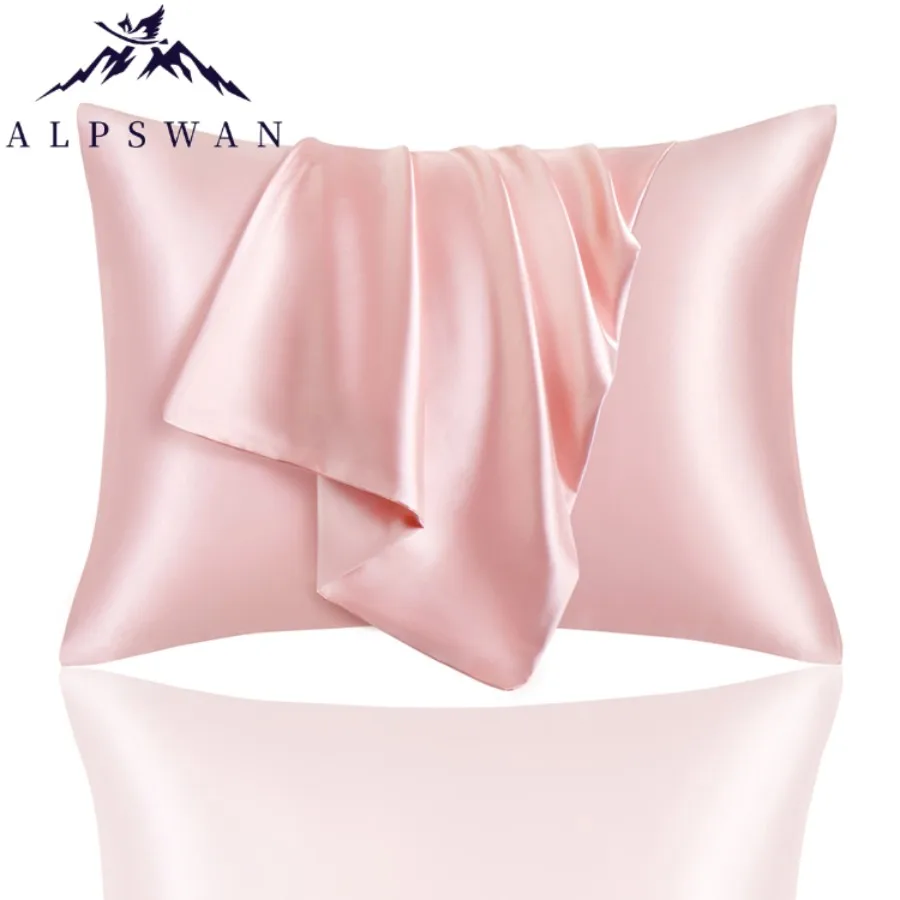
For those concerned about maintaining healthy hair, our selection of silk pillowcases offers an easy way to experience these benefits without committing to a complete bedding overhaul.
Sleep Quality Factors: Temperature Regulation and Comfort
Temperature Control
The ability to maintain optimal sleeping temperature significantly impacts sleep quality, and the fabric choice plays a crucial role in this aspect.
Silk’s protein structure creates remarkable natural thermoregulation properties. It adapts to body temperature, providing cooling effects during warm nights while offering insulation during colder conditions. This makes silk an excellent year-round bedding option that adjusts to your body’s needs rather than imposing a single temperature profile.
Cotton, while breathable, offers more limited temperature regulation capabilities. It excels at heat dissipation and moisture absorption, making it suitable for hot sleepers and warm environments. However, it provides less effective insulation in cooler conditions compared to silk.
Moisture Management During Sleep
The human body naturally releases moisture during sleep—up to a cup of sweat per night for some individuals. How fabrics handle this moisture affects sleep comfort.
Silk has the unique ability to wick away moisture without absorbing it. It can absorb approximately 30% of its weight in moisture without feeling damp, maintaining a dry sleep surface. This property helps maintain both skin hydration and comfortable sleep temperature.
Cotton’s high absorption capacity (up to 25 times its weight in water) effectively pulls moisture away from the body but holds onto it. This can create a damp sleeping environment if significant moisture is present, potentially disrupting sleep comfort as the night progresses.
Tactile Comfort
The psychological effects of fabric feel on sleep quality shouldn’t be underestimated:
- Silk’s smooth, gentle touch creates a luxury sensation that many find promotes relaxation
- The lightweight drape of silk provides comfort without feeling restrictive
- Cotton’s familiar crisp feel offers comfort through familiarity for many sleepers
- Individual sensory preferences play a significant role in which fabric promotes better sleep initiation
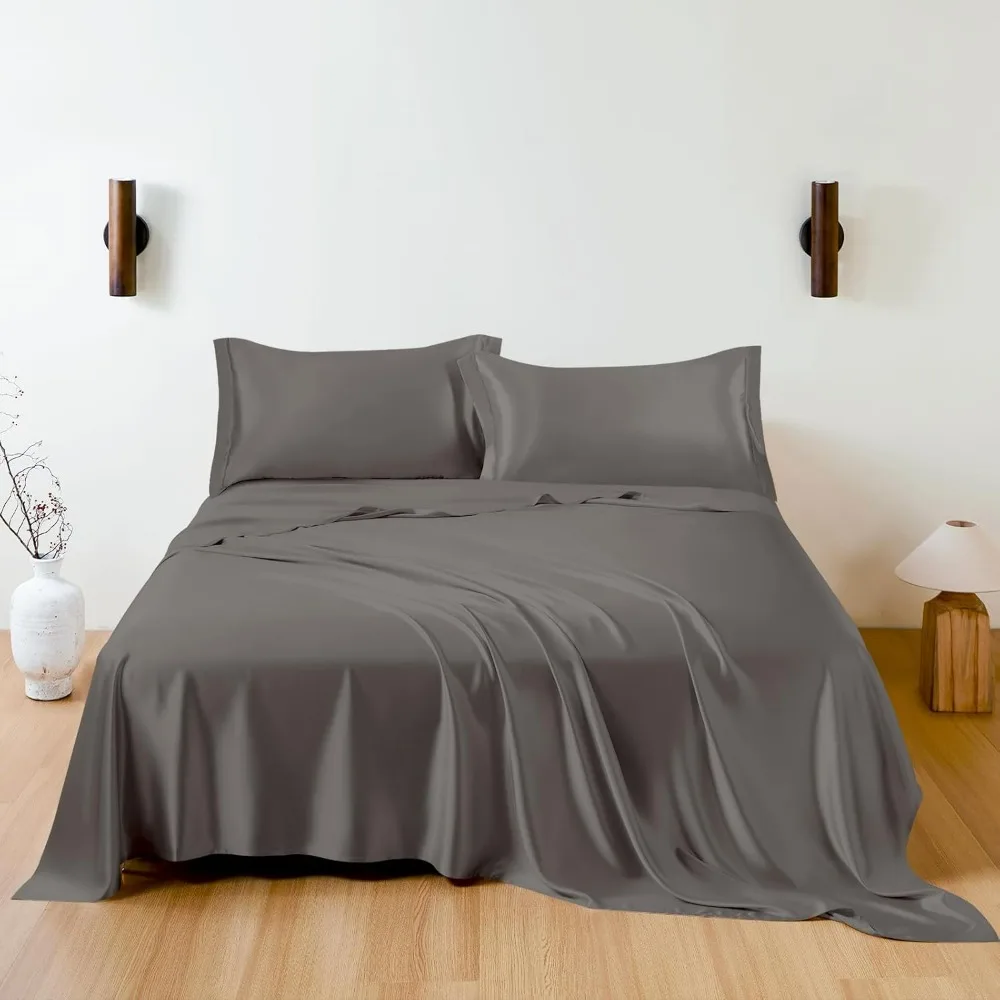
For those interested in improving their sleep quality, exploring how to transform sleep quality with silk provides valuable insights. Hot sleepers particularly benefit from cooling silk sheets designed to maximize temperature regulation benefits.
Durability and Care: Longevity Considerations
Silk Longevity Factors
Despite its delicate appearance, properly cared for silk can be surprisingly durable. The momme weight plays a crucial role in silk’s longevity—fabrics in the 19-25 momme range offer the optimal balance between luxurious feel and durability for bedding applications.
To maximize silk’s lifespan:
– Wash in cold water using mild detergents specifically formulated for silk
– Avoid bleach and fabric softeners which damage silk fibers
– Air dry or use dryer on lowest heat setting
– Store away from direct sunlight to prevent fading
Many people mistakenly believe silk is too fragile for regular use, but premium silk bedding with proper care can last many years, often outlasting lower-quality cotton alternatives despite the higher initial investment.
Cotton Durability
Cotton’s durability correlates with its quality metrics:
– Higher thread counts (generally 300-600) typically indicate better longevity
– Long-staple cotton varieties offer superior durability over standard cotton
– Cotton typically shows wear through pilling, thinning, and color fading
– Most cotton bedding withstands frequent machine washing with standard detergents
– Cotton generally requires replacement more frequently than quality silk
For those concerned about care requirements, our washable silk sheets offer easier maintenance while maintaining the benefits of silk.
Full-size Silk Sheets, King Size Silk Sheets, Queen Size Silk Sheets, Twin Size Silk Sheets, Washable Silk Sheets
Price range: $95.95 through $178.37 Select options This product has multiple variants. The options may be chosen on the product page100% Silk Sheets, Green Silk Sheets, King Size Silk Bedding Set, Mulberry Silk Bedding Sets, Queen Size Silk Bedding Set
Price range: $1,246.21 through $1,615.22 Select options This product has multiple variants. The options may be chosen on the product pagePink Silk Sheets, Twin Size Silk Sheets
$171.80 Select options This product has multiple variants. The options may be chosen on the product pageFull-size Silk Sheets, Pink Silk Sheets
$136.31 Select options This product has multiple variants. The options may be chosen on the product pageGrey Silk Sheets, Silk Sheet and Pillowcase Set
Price range: $88.20 through $146.64 Select options This product has multiple variants. The options may be chosen on the product pageBamboo Silk Sheets, Cooling Silk Sheets
Price range: $130.76 through $177.80 Select options This product has multiple variants. The options may be chosen on the product page
Investment Value: Cost Analysis Beyond Price Tags
When evaluating silk versus cotton, the initial price difference is significant—quality silk bedding typically costs several times more than premium cotton alternatives. However, this straightforward price comparison doesn’t tell the complete value story.
The true investment value comes from considering:
- Longevity: Quality silk sheets (19-25 momme) often last 5-10+ years with proper care, while even premium cotton typically requires replacement after 2-3 years of regular use.
- Health benefits: The potential improvements to skin and hair condition represent value beyond the fabric itself.
- Sleep quality: Better sleep through improved temperature regulation and comfort offers substantial value to overall wellbeing.
When calculated as cost-per-use over the product lifespan, the gap between silk and cotton narrows considerably. For example, a $300 silk pillowcase used nightly for five years costs approximately 16 cents per use—a modest investment in daily comfort and potential health benefits.
Our diverse selection of silk sheets offers options at various price points, allowing customers to find the right balance between luxury and budget.
Ideal Applications: When to Choose Each Fabric
Best Uses for Silk
Silk excels in several specific applications:
- Luxury bedding: Particularly pillowcases and sheets where direct skin contact maximizes benefits
- Sleepwear: For those seeking skin and hair benefits throughout the night
- Special occasion clothing: Where elegance and comfort are paramount
- For sensitive skin: The hypoallergenic properties benefit those with skin conditions
- Temperature regulation needs: Especially for couples with different sleep temperature preferences
Best Uses for Cotton
Cotton remains the practical choice for many situations:
- Everyday bedding: Particularly for children or guest rooms
- Casual clothing: For breathable comfort in everyday wear
- Sports and high-activity applications: Where high absorption of moisture is beneficial
- Budget-conscious purchases: When initial cost is the primary consideration
- Extremely hot climates: Where maximum moisture absorption may be preferred
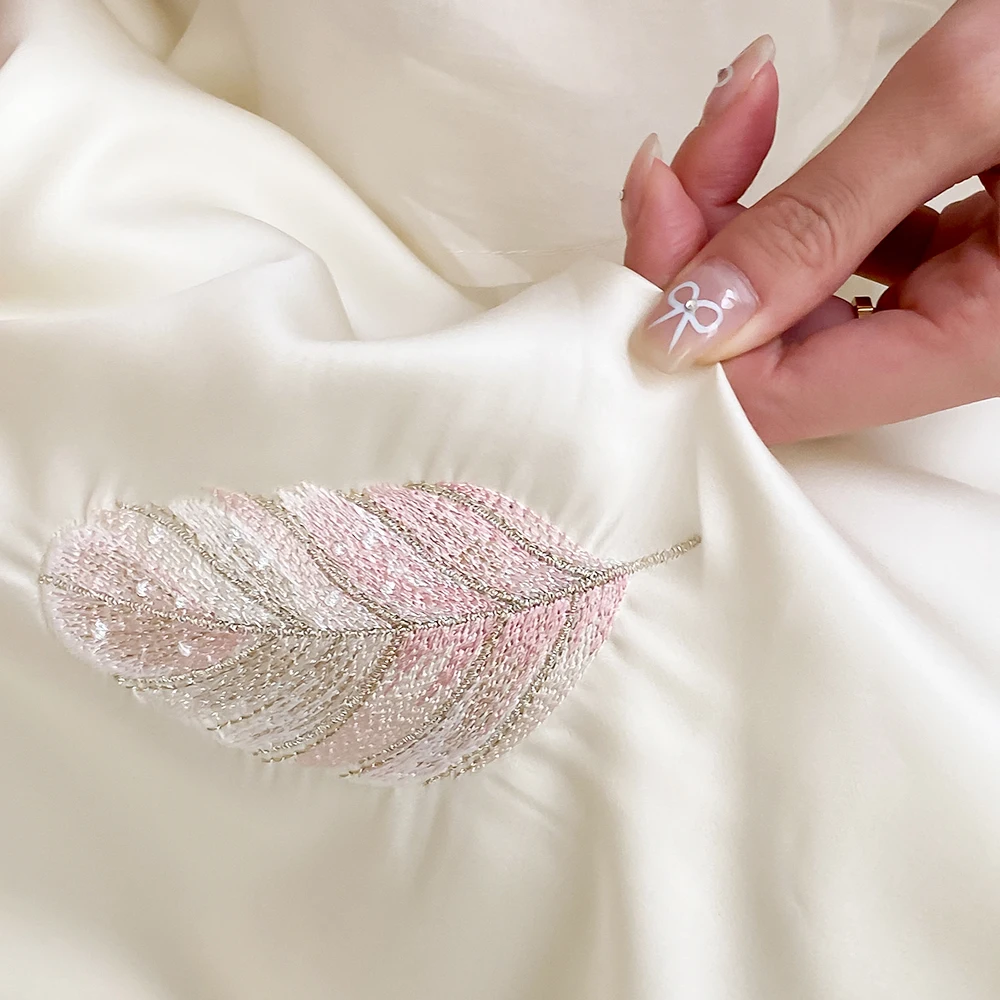
For a deeper dive into how these fabrics perform specifically in sleep applications, our comparison of silk and cotton fabrics for sleep provides valuable insights.
Making Your Decision: Personal Factors to Consider
When deciding between silk and cotton, consider asking yourself these key questions:
What is your primary concern?
– Skin health and appearance
– Hair protection and maintenance
– Temperature regulation while sleeping
– Budget constraints
– Ease of care and maintenanceWhat specific use are you considering?
– Bedding (pillowcases, sheets, duvet covers)
– Clothing (sleepwear, daywear, formal wear)
– Accessories (scarves, masks)Do you have special health considerations?
– Allergies or sensitivities
– Skin conditions like eczema or rosacea
– Hair concerns like breakage or frizzWhat is your climate and sleeping temperature preference?
– Do you sleep hot or cold?
– Does your local climate experience extreme conditions?
– Do you share your bed with someone with different temperature preferences?
Many people find that a hybrid approach works well—starting with silk pillowcases for maximum hair and facial skin benefits, then gradually adding other silk bedding pieces as budget allows.
Understanding the comprehensive advantages of sleeping on Mulberry silk can help weigh these factors appropriately.
Frequently Asked Questions: Common Concerns Addressed
Is silk worth the higher price?
For those prioritizing skin health, hair protection, temperature regulation, and luxury feel, silk’s benefits typically justify the investment, especially when considering cost-per-use over its longer lifespan.
What exactly makes silk hypoallergenic?
Silk’s natural properties resist dust mites, mold, and fungus growth. Its smooth fibers also create fewer irritation points for sensitive skin, and the fabric doesn’t contain the chemical residues sometimes found in cotton processing.
Can cotton ever match silk’s benefits for hair?
While high-quality, smooth cotton fabrics can reduce some friction, they cannot match silk’s natural properties for hair protection. Cotton’s absorption of natural hair oils and higher friction surface fundamentally affects hair differently.
How do vegan silk alternatives compare to real silk?
Plant-based silk alternatives have improved significantly, offering similar smoothness and some temperature-regulating properties. However, most still don’t fully replicate all the natural protein-based benefits of true silk, particularly for skin health.
What cotton quality indicators should I look for?
For cotton bedding, look for long-staple cotton varieties (Egyptian, Pima, or Supima), thread counts between 300-600 (higher isn’t always better), and certifications for organic or sustainable production if environmental concerns are important to you.
For more information about silk quality, explore whether Mulberry silk sheets are worth the investment.
Debunking Common Myths: Separating Fact from Fiction
Myth: “Silk is too delicate for regular use”
Fact: Quality silk with appropriate momme weight (19-25 for bedding) is surprisingly durable when properly cared for, often outlasting cotton alternatives.
Myth: “Cotton is always better for hot weather”
Fact: While cotton absorbs moisture well, silk’s temperature-regulating properties can actually provide better comfort in hot weather by wicking away moisture without retaining it.
Myth: “Silk requires dry cleaning”
Fact: Most modern silk bedding can be hand washed or machine washed on a delicate cycle with appropriate silk detergent, making it much more practical for everyday use.
Myth: “Higher thread count cotton is always better”
Fact: Extremely high thread counts (above 600) often indicate thread manipulation rather than quality improvement. The optimal thread count range for cotton is generally between 300-600, depending on the specific cotton type.

